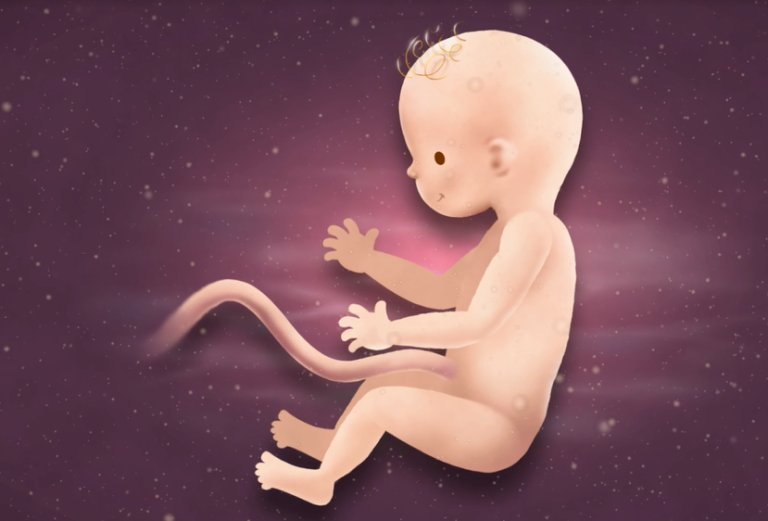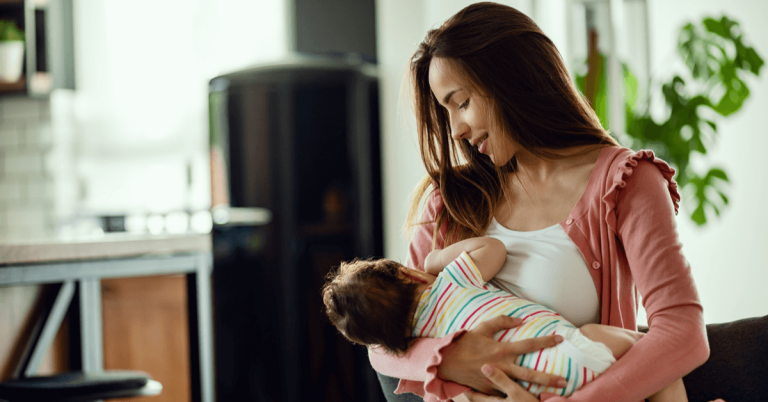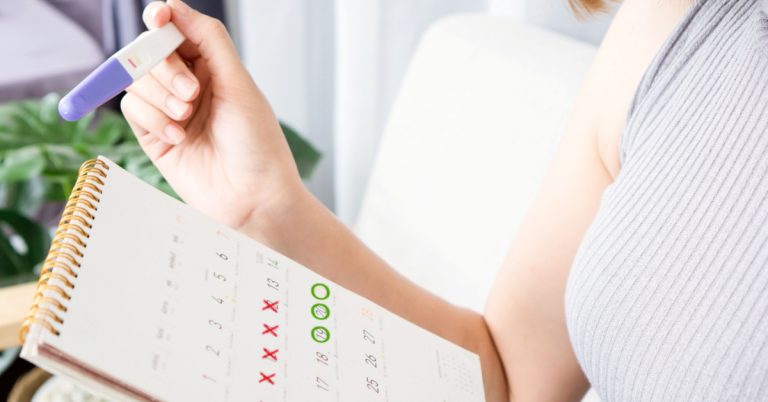In week twenty-two of pregnancy, you are still in the second trimester. While you were counting the days and dreaming of holding your baby in your arms, you left more than half of this pregnancy behind. You and your baby, in close collaboration, have come a long way together. Learning how your baby is developing, what to expect and what can help you to cope better will make you feel empowered and in control.
Your Baby at Twenty-Two Weeks
While your tummy is becoming round like a balloon, your little one has grown enough to fill your hand palms. Let us see what a twenty-two-week-old foetus’s development looks like.
How Big is Your Baby at Twenty-Two Weeks?
Your little one grows, develops, and acquires new skills every day, even while you sleep. He is now almost the size of a coconut. You can find the average size of a twenty-two-week-old foetus in the table below.
| Gestational Age | Weight | Length |
| 22nd week | 330−400 gr | 19−22 cm |
These values are averages and may vary from baby to baby due to differences in the moment of fertilisation, which cannot be determined exactly. If fertilisation occurred later than expected, your baby’s values might be lower. Not the exact figures, but your baby’s development is important. Your doctor will tell you if there is cause for concern or not.
Development of the Organ Systems and New Skills
While you are dreaming of having a healthy baby with cotton skin and rosy cheeks in your lap, your little one is working hard to prepare for this day. The development of his organs and organ systems is as follows:
- The Nervous System
Because of the myelin sheath surrounding the nerve cells, neural impulses can be transmitted faster. Nerve endings that connect different neurons are developing and will ensure that the whole body is controlled by the central and peripheral nervous systems.
Along with the brain, the cerebellum, the medulla oblongata, and the spinal cord rapidly develop. These structures supervise and regulate not only the involuntary internal organs but also the voluntary musculoskeletal system. The baby can now move of his own accord.
Your little one already has a regular sleep-wake pattern, alternating periods of sleep with periods of wakefulness.
- The Circulatory System
The heart beats about 100-150 times per minute, pumping blood throughout the foetus’s body. The bones continue to produce blood, increasing the blood volume. In response, the vessels become thicker and more durable.
- The Digestive System
The anal sphincter, the muscle structure that works voluntarily and involuntarily to defecate, has completely gained its function, but defecation will occur only after birth. At the moment, your baby’s stomach is filled and emptied with amniotic fluid many times, and the digestive waste accumulates in the intestine without defecation.
- The Respiratory System
Your baby is busy practising breathing. His chest rises and falls, and the lungs fill with amniotic fluid. The borders between the alveoli and blood vessels are thinning. This will continue until oxygen and carbon dioxide can pass through.
- The Musculoskeletal System
The skeletal system and tooth roots are strengthened, and the cartilage structures ossify or harden with the calcium from your food and calcium reserves. The muscles grow increasingly stronger, so, your baby can now move his arms and legs with ease.
- The Urinary System
Your baby swallows amniotic fluid, digests it, secretes it in the form of urine, and then swallows it again. This wonderful cycle will continue until birth.
- The Reproductive System
Your baby’s reproductive organs have formed a while ago. A female baby’s ovaries, uterus, and vagina gradually mature. In male babies, the testicles will start descending into the scrotum slowly. If you are still eagerly waiting to find out the gender of your baby, your doctor will probably tell you this week.
The Endocrine and Immune Systems
A foetus’s external world consists of amniotic fluid. As his defence system is still not strong, he needs something to protect him from its effects. The creamy layer called vernix caseosa, which covers his skin, is what protects him.
In the twenty-second week of pregnancy, the IgG antibodies produced by the expectant mother have just begun to pass to the baby through the placenta. These will increase over time and protect your baby from diseases during pregnancy as well as immediately after birth.
Your Baby’s Movements at Twenty-Two Weeks
Your baby’s skeletal structure is gradually changing from cartilage to bone. The bones have grown longer, the joints are functioning, and the muscles are getting stronger by the day. This means you will probably be able to sense your baby’s movements. You may feel tiny wiggles and shifts and you will even notice when your little one rhythmically hiccups. Prospective fathers have to wait just a little longer but will be able to witness this miracle in a week or two as well.
A Twenty-Two-Week-Old Foetus’s Sense Organs
This is an exciting time for the sense organs, as they have now developed enough to allow your baby to perceive the outside world.
- The Eyes and the Sense of Sight
Tear ducts are forming, and his eyelashes and eyebrows have become visible. His eyelids are fully developed, but he still cannot open and close them. While the vision receptors increase in number, they also improve their functionality. His eyesight has matured enough to perceive the difference between day and night, even though his eyes are still closed. You can test this with a flashlight. Wait for a while in the dark with your stomach exposed. Then shine on your belly with a flashlight. You will notice that your baby starts wiggling in response.
- The Ears and the Sense of Hearing
As the bones in the inner ear continue to harden, your baby’s hearing and sense of balance also develop. Some babies’ hearing receptors have developed enough to hear their mother’s voice, heartbeat, and stomach rumbling now. Still, most babies can only hear sounds at frequencies that an adult ear cannot hear.
- The Skin and the Sense of Touch
The sense of touch in your baby’s hands is the most sensitive. Your little one will test this out by grasping his umbilical cord, nose, hands, and feet. Other parts of his body also begin to perceive sensations such as warm, cold, pressure, and pain. Hairs are now visible from the follicles on the scalp. His body is still covered with lanugo hairs, which serve as thermal insulation. The thick, white, creamy vernix caseosa covering the skin protects your baby from the effects of the amniotic fluid.
- The Tongue and the Sense of Taste
Your baby’s sense of taste is very well developed, and he is enjoying different tastes already. He perceives the flavours of the food you eat in the amniotic fluid. Your little one is already developing food preferences in the womb!
- The Nose and the Sense of Smell
The olfactory receptors located in the nose are now very well developed. Your baby can detect the odour of foods and the substances in the amniotic fluid that enters his nose.
How Many Months is Your baby at Twenty-Two Weeks?
Pregnancy is an adventure that lasts nine months and ten days, corresponding to forty weeks. Although we are used to expressing this period in months, your doctor will talk about weeks. So, how can you convert the number of weeks into months? Let us calculate this together:
22 weeks = 22×7 days = 154 days
154/30= 5 months 4 days
In short, a twenty-two-week-old foetus is a little over five months old.
Your Body at Twenty-Two Weeks of Pregnancy
As time flies by, you are rapidly getting closer to birth and some pregnancy issues may start to bother you. Let us see what awaits you at twenty-two weeks of pregnancy.
Insomnia
As we approach the end of the second trimester, pregnancy symptoms cause insomnia. Back and leg aches, oedema, heartburn, reflux, a frequent urge to urinate, etc. are increasing and form obstacles to a good night’s sleep.
Haemorrhoids
Haemorrhoids are one of the most common pregnancy symptoms. The increased blood volume causes the swelling of certain veins, among others in your rectum. These are called haemorrhoids. Sometimes they also protrude from the body due to the pressure of your uterus on the intestines. If part of the intestine is pushed out of the anus, this is called rectal prolapse. If you do not take precautions, it may negatively affect your quality of life by causing pain and suffering in the future.
Feet Growth
If your friend, who normally wears size 38 shoes, told you: “By the time of birth, I had a size 40!” she was definitely not exaggerating. During pregnancy, the feet expand for two reasons, oedema, and pregnancy hormones.
Pregnancy hormones widen the pelvis by loosening the ligaments between the hip, sacrum, and coccyx to make room for the baby. This also manifests in the bones of the feet. The mother’s increased weight on the loosened ligaments causes the foot bones to widen and the feet to expand. This may be permanent and you may have to buy larger shoes. Besides that, oedema may also cause your feet to swell. This is temporary and will disappear shortly after birth.
Stretch marks
Stretch marks, which were most visible on the abdomen up till now, may also appear on your breasts and hips as of the twenty-second week of pregnancy, due to your weight gain and your baby’s growth. These scars, which are pink, light purple and sometimes white, are permanent. The best you can do is prevent them.
Abdominal pain and cramping
As the uterus grows, the abdominal muscles are strained, causing pain, and cramping in the abdominal and groin area. Sometimes you may experience Braxton Hicks contractions in your abdomen for a while, which you may confuse with labour pain. Unlike labour pain, they are irregular and do not increase over time. There is no need to panic because they usually stop on their own after a little while.
Pelvic pain
Pregnancy hormones relax the muscles between the bones in the pelvis to make room for the growing uterus. In combination with the increased weight of your baby, this may cause pelvic pain.
Hot flashes
Hormonal changes, a faster heartbeat, increased blood volume, and the acceleration of your metabolism may cause you to experience hot flashes.
Increase in Sexual Desire
As the pregnancy hormones reach their maximum level, and the pelvic region receives an increased blood flow, you may experience an increase in sexual desire. Unless your doctor tells you otherwise, it is okay to have sexual intercourse in positions that do not put pressure on your abdomen.
Important Tips to Minimise Uncomfortable Pregnancy Issues
Although the twenty-second week of pregnancy in the second trimester is still called the golden period of pregnancy, your body may have difficulties adapting to all the changes. We have collected a number of suggestions to help you minimise the uncomfortable symptoms.
First of all, many symptoms are related to your increasing weight, so controlled weight gain is immensely helpful. Eating small portions regularly, in the form of three main meals and three snacks is a safe way to start. Avoid eating for two because you are pregnant. It is sufficient to eat an extra 300-350 calories. Avoid consuming too many fried foods, pastries, sweets, white bread, processed meat, packaged snacks and other low-quality foods. Do not consume sugary drinks such as cola, fruit juice, or soda. Drink at least two litres of water per day and consume fibre-rich foods.
Stretch marks are permanent scars and although they may not bother you much now, as you are focusing on growing a healthy baby, they may bother you in the future. Preventing them is key. Ask for your doctor’s advice about which products to use. Almond oil, aloe vera gel, or stretch mark creams you can find in the pharmacy generally give your skin the necessary elasticity.
Avoid standing on your feet for a long time. Sit or lie down and rest whenever possible.
If you experience frequent hot flashes, wearing thin, breathable, cotton clothes, taking lukewarm showers, and consuming plenty of fluids, may help.
How Much Weight Should You Gain?
It is unlikely that you can still wear your old clothes these days. So, how much weight gain is normal at twenty-two weeks of pregnancy? A healthy weight gain is 5 to 7 kilos. If you experienced intense nausea and vomiting in the first trimester, you may not have gained as much, but you will also start gaining in the coming weeks. If you experience an increased appetite, you can eat a little more (300-350 calories), but avoid excessive weight gain, as this will cause all sorts of issues and make it hard for you to return to your pre-pregnancy weight. It is useful to follow up on your weight gain with your doctor and to get help from a dietitian if necessary.
Twenty-Two-Week Pregnancy Checklist
It is the ideal time to start shopping for your baby. Start planning your little one’s room, which colours you want to paint the walls, etc.
Start searching for a name now. If you leave this to the last moment, you might end up with a name that does not suit you and regret it later.
The twenty-second week is the last option for the detailed anatomy scan. With this scan, your doctor will receive data on the development of the baby’s limbs and internal organs, such as the heart, kidneys, and lungs, and will be able to evaluate the possibility of certain genetic anomalies.
If you are considering giving birth with the support of a doula, start researching now.
Start preparing a birth plan and choose where you want to give birth and with which doctor.
Living consciously during the miracle that is pregnancy is important for your health and that of your baby. Therefore, it is useful to know what awaits you and your baby from week to week







